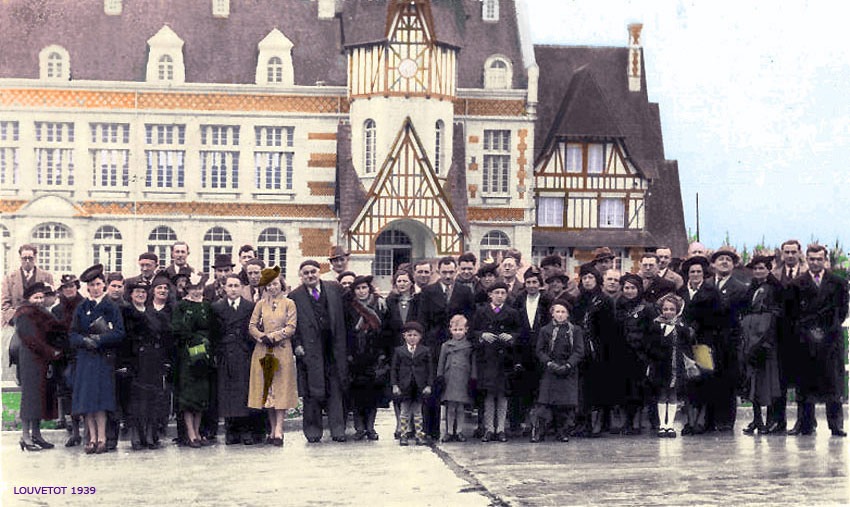Radio Normandie, la fierté des Normands
et leur toute première radio libre
Dans les années 30, les pionniers dynamiques normands n’ont pas raté les débuts de la TSF - la Téléphonie Sans Fil, comme on dit à l’époque : l’ancêtre des radios libres s’appelle Radio Normandie ! D’abord situé à Fécamp puis à Louvetot entre Yvetot et Caudebec-en-Caux, le poste est très écouté. Il émet alternativement en français et en anglais pendant la journée jusqu’au soir, puis continue en anglais une bonne partie de la nuit après minuit. Le dimanche, les programmes anglais occupent la majeure partie de la journée. Cette abondance de programmes étrangers provoque quelques frustrations chez les auditeurs normands réfractaires à la langue de Shakespeare ! Néanmoins, ils apprécient les nombreux orchestres de jazz qui sont diffusés. La musique est internationale et les ondes hertziennes ignorent merveilleusement les frontières linguistiques, terrestres et... maritimes, au grand désarroi de nos représentants politiques !
Fernand Le Grand dont le grand père inventa la liqueur Bénédictine, est président du Radio-Club de Fécamp, un club d’amateurs enthousiastes de la  TSF qu’il a créé en janvier 1924. Sa station d’amateur dont l’indicatif est EF8IC, prend le nom de “Radio Fécamp” le 17.11.1926 et démarre de véritables émissions radiophoniques en 1927 depuis le salon familial de sa propriété. Soutenue par la municipalité de Fécamp, la station annonce les cours de la pêche et en particulier ceux du hareng très suivis par les marins, les armateurs et les industriels fécampois. Radio Fécamp est une station très dynamique et rassemble autour de son micro des personnalités locales. D’abord ignorée sur la liste des stations autorisées par le décret de juillet 1928 - Fécamp était déjà si loin de Paris ? - elle bénéficie tardivement d’un décret d’autorisation le 24 janvier 1929, grâce à l’intervention d’un député du Havre et du ministre du commerce et de l’industrie. Comme c’est souvent le cas pour les stations privées en litige avec l’administration, les élus régionaux se mobilisent et obtiennent du gouvernement la reconnaissance et les autorisations nécessaires. Maintenant officialisée, la station va pouvoir se développer. De statut local, son prestige devient régional et après une augmentation de puissance, elle prend le nom de Radio Normandie. Un studio est inauguré au Havre avec le concours de la municipalité. TSF qu’il a créé en janvier 1924. Sa station d’amateur dont l’indicatif est EF8IC, prend le nom de “Radio Fécamp” le 17.11.1926 et démarre de véritables émissions radiophoniques en 1927 depuis le salon familial de sa propriété. Soutenue par la municipalité de Fécamp, la station annonce les cours de la pêche et en particulier ceux du hareng très suivis par les marins, les armateurs et les industriels fécampois. Radio Fécamp est une station très dynamique et rassemble autour de son micro des personnalités locales. D’abord ignorée sur la liste des stations autorisées par le décret de juillet 1928 - Fécamp était déjà si loin de Paris ? - elle bénéficie tardivement d’un décret d’autorisation le 24 janvier 1929, grâce à l’intervention d’un député du Havre et du ministre du commerce et de l’industrie. Comme c’est souvent le cas pour les stations privées en litige avec l’administration, les élus régionaux se mobilisent et obtiennent du gouvernement la reconnaissance et les autorisations nécessaires. Maintenant officialisée, la station va pouvoir se développer. De statut local, son prestige devient régional et après une augmentation de puissance, elle prend le nom de Radio Normandie. Un studio est inauguré au Havre avec le concours de la municipalité.
Mais M. Le Grand est loin d’imaginer que sa station va connaître une notoriété bien plus importante au-delà de la région. Car, avec la mer comme principal horizon, le poste fécampois est perçu en Angleterre, un pays dépourvu de radios commerciales.
La publicité radiophonique y est proscrite et de plus, la BBC, l’unique organisme de radio autorisé, fait relâche le dimanche (Sunday is closed comme l’on disait) et ne diffuse que de lascifs chants religieux toute la journée, à laisser croire que le roi George V est mort et le pays est en deuil ! Enviant les Continentaux, les Britanniques eux aussi désireraient se divertir derrière leurs postes de radio.
Voilà qui fait réfléchir et découvrir des perspectives alléchantes ! Avantage supplémentaire comme chacun le sait, la mer, immense miroir, décuple la propagation des ondes, lesquelles se moquent bien des législations en vigueur et franchissent impunément le Channel. Le soir venu, les émissions “étrangères” de Radio Normandie, du Poste Parisien et celles de Radio Luxembourg sont captées par des milliers de britanniques frustrés du Royaume Uni. Une aubaine à exploiter !
Conscient des possibilités commerciales offertes et des profits envisageables, un homme d’affaires britannique, le Captain Leonard Plugge et ses associés, des financiers londoniens, rencontrent M. Le Grand en 1931. Ils entrent dans le capital de Radio Normandie.
Très vite, des émissions en langue anglaise enregistrées à Londres sur disques 78 tours, apparaissent pendant les pauses des émissions françaises sur l’émetteur. Ainsi, les programmes de Radio Normandie et Radio Normandy font la joie des auditeurs de part et d’autre de la Manche ! Après une nouvelle augmentation de la puissance (toujours sans autorisation) à 20 kW, les émissions déjà entendues sur la côte Sud de l’Angleterre, parvien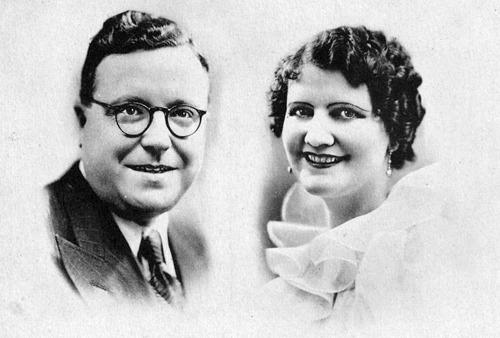 nent claires et nettes en pleine journée à Londres (à 200 km de Fécamp). La nuit, elles atteignent au Nord, les Midlands et les villes peuplées de Birmingham, Coventry. Côté français, nos parents et grands parents se souviennent de Tante Francine (Francine Lemaître) la première speakerine, d’Oncle Roland (Roland Violette), de l’accordéoniste Roger Queval accompagné de tout l’orchestre de Radio Normandie. Côté britannique, Roy Plomley, Ian (David) Newman, Bob Danvers Walker (Uncle Bob), David J. Davies, Howard V. Gee, E.J. Oestermann se succèdent au micro et assurent l’enchaînement des émissions en anglais, avec l’assistance d’un technicien français. nent claires et nettes en pleine journée à Londres (à 200 km de Fécamp). La nuit, elles atteignent au Nord, les Midlands et les villes peuplées de Birmingham, Coventry. Côté français, nos parents et grands parents se souviennent de Tante Francine (Francine Lemaître) la première speakerine, d’Oncle Roland (Roland Violette), de l’accordéoniste Roger Queval accompagné de tout l’orchestre de Radio Normandie. Côté britannique, Roy Plomley, Ian (David) Newman, Bob Danvers Walker (Uncle Bob), David J. Davies, Howard V. Gee, E.J. Oestermann se succèdent au micro et assurent l’enchaînement des émissions en anglais, avec l’assistance d’un technicien français.
NB : durant les émissions anglaises, le règlement intérieur stipulait la présence d’un membre du personnel français aux côtés du speaker anglais. On ignore les raisons. Aide technique ou contrôle de l'antenne peut-être ?
La station est en pleine expansion mais la puissance de l’émetteur dont les antennes surplombent la ville, sature les récepteurs (peu sélectifs à l’époque) des Fécampois mécontents de ne pouvoir entendre les autres stations lointaines sans éliminer totalement le son de Radio Normandie toujours présent en arrière plan. Le projet de déménagement de l’émetteur est donc envisagé. En 1938, la station d’émission est transférée au cœur du pays de Caux à Louvetot où, au milieu d’un domaine de 3 hectares, un  émetteur flambant neuf est construit au pied d’un pylône de forme révolu-tionnaire type “Blaw-Knox” de 154 m de hauteur qui va considérablement augmenter la portée des émissions. Quelques kilomètres en contrebas, au bord de la Seine, de nouveaux studios occupent un château, le futur Hôtel de Ville de Caudebec-en-Caux. Un câble coaxial de 6 kilomètres posé à travers la Forêt de Maulévrier, relie les studios à l’émetteur. Grâce aux radios-clubs associés, d’autres studios (on disait “auditoriums”) sont créés à Rouen, au Havre, au Tréport, au Touquet et à Paris (au siège du journal Paris-Soir pour retransmettre le bulletin d’infos), tous reliés à Caudebec par lignes téléphoniques PTT : la qualité technique du son à cette époque était assez sommaire ! émetteur flambant neuf est construit au pied d’un pylône de forme révolu-tionnaire type “Blaw-Knox” de 154 m de hauteur qui va considérablement augmenter la portée des émissions. Quelques kilomètres en contrebas, au bord de la Seine, de nouveaux studios occupent un château, le futur Hôtel de Ville de Caudebec-en-Caux. Un câble coaxial de 6 kilomètres posé à travers la Forêt de Maulévrier, relie les studios à l’émetteur. Grâce aux radios-clubs associés, d’autres studios (on disait “auditoriums”) sont créés à Rouen, au Havre, au Tréport, au Touquet et à Paris (au siège du journal Paris-Soir pour retransmettre le bulletin d’infos), tous reliés à Caudebec par lignes téléphoniques PTT : la qualité technique du son à cette époque était assez sommaire !
L’état français avide de contrôle (son obsession perpétuelle), cherchera à s’approprier la puissante station de Radio Normandie à tout prix. Toutefois, celle-ci conservera son autonomie. Première radio privée de province, elle va assurer un service régulier jusqu’à la guerre (7.09.1939) avant d’être réquisitionnée par l’état, parvenu à ses fins. Mais très vite, les Nazis investissent les lieux et s’approprient la station pour relayer le programme pro-allemand de Radio Paris. L’émetteur est bombardé par l’aviation alliée. Ce qu’il reste du pylône sera abattu par la Wehrmacht comme ultime chef d’œuvre, lors de la débâcle. Les postes émetteurs français encore intacts sont sabotés et détruits par l’armée allemande au moment de sa retraite.
A la Libération, l’état français institue sans tarder le monopole des ondes qui lui tenait tant à cœur avant les hostilités. Naturellement les autorisations accordées aux anciennes radios privées ne sont pas reconduites, car l’état convaincu que “toute activité destinée à satisfaire un besoin d’intérêt général doit être assurée et contrôlée très étroitement par lui-même et son administration” : le Service public.
En conséquence, la RTF (Radiodiffusion et Télévision Française) voit le jour en 1949. Elle obtient le monopole d’exploitation de la radiodiffusion.
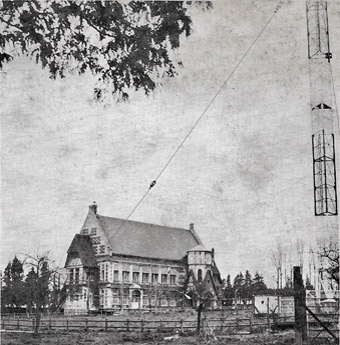 Après la reconstruction d’un pylône d’émission de taille plus modeste (120 mètres), l’émetteur de Louvetot devra relayer sur 214 m (1403 kHz), les programmes nationaux depuis Paris : “Programme Parisien”, “France Inter Variétés”, puis “France Culture”. Cette mainmise de l’état sur les installations exclut définitivement tout projet de radio régionale, exceptés quelques rares et brefs décrochages durant les années 60 qui n’auront aucune suite, faute d’audience ou plutôt un manque de volonté de poursuivre l’expérience. (...) Après la reconstruction d’un pylône d’émission de taille plus modeste (120 mètres), l’émetteur de Louvetot devra relayer sur 214 m (1403 kHz), les programmes nationaux depuis Paris : “Programme Parisien”, “France Inter Variétés”, puis “France Culture”. Cette mainmise de l’état sur les installations exclut définitivement tout projet de radio régionale, exceptés quelques rares et brefs décrochages durant les années 60 qui n’auront aucune suite, faute d’audience ou plutôt un manque de volonté de poursuivre l’expérience. (...)
JC Dumenil - texte extrait du livre "Une Radio libre en pays de Caux" |
Radio Normandy, the pride of the Normans
and their very first free radio
In the 1930s, the dynamic pioneers of Normandy didn't miss out on the beginnings of TSF - Wireless Telephony, as it was known at the time: the forerunner of free radio was called Radio Normandie! First located in Fécamp, then in Louvetot between Yvetot and Caudebec-en-Caux, the station was very popular. It broadcast alternately in French and English during the day and into the evening, then continued in English for most of the night after midnight. On Sundays, English programmes take up most of the day. This abundance of foreign programmes is a source of some frustration for listeners in Normandy who are resistant to the language of Shakespeare! Nevertheless, they appreciate the many jazz orchestras that are broadcast. Music is international and the airwaves are wonderfully free of linguistic, land and sea borders, much to the dismay of our political representatives!
Fernand Le Grand, whose grandfather invented Benedictine liqueur, was president of the Radio-Club de Fécamp, a club of amateur radio enthusiasts that he founded in January 1924. His amateur station, with the call sign EF8IC, took the name "Radio Fécamp" on 17.11.1926 and began broadcasting in 1927 from the family room on his property.
Supported by the Fécamp town council, the station announced fishing prices, particularly herring prices, which were very popular with Fécamp sailors, shipowners and industrialists. Radio Fécamp was a very dynamic station, bringing together local personalities around its microphone.
Initially ignored on the list of stations authorised by the decree of July 1928 - Fécamp was already so far from Paris? - It was only later, on 24 January 1929, that it was granted a decree of authorisation, thanks to the intervention of a member of parliament from Le Havre and the Minister for Trade and Industry. As is often the case for private stations in dispute with the authorities, the regional councillors took action and obtained the necessary recognition and authorisations from the government. Now official, the resort was able to develop.
From local status, its prestige became regional, and after an increase in power, it took the name Radio Normandie. A studio was inaugurated in Le Havre with the help of the local council.
But Mr Le Grand had no idea that his station would become much better known beyond the region. With the sea as its main horizon, the Fécamp station was perceived in England, a country with no commercial radio stations. Radio advertising was outlawed and, what's more, the BBC, the only authorised radio organisation, had a Sunday off (Sunday is closed, as they used to say), broadcasting nothing but lascivious religious songs all day long, giving the impression that King George V had died and the country was in mourning! Envious of the Continentals, the British would also like to be entertained behind their radios.
Now that's food for thought, and some tantalising prospects! An added advantage, as we all know, is that the sea is an immense mirror, allowing waves to propagate tenfold, making a mockery of current 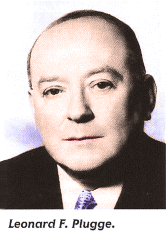 legislation and crossing the Channel with impunity. In the evenings, the 'foreign' broadcasts of Radio Normandie, Le Poste Parisien and Radio Luxembourg are picked up by thousands of frustrated Britons in the UK. A windfall to be exploited! Aware of the commercial opportunities available and the profits that could be made, a British businessman, Captain Leonard Plugge, and his associates, London financiers, met with Mr Le Grand in 1931. They acquired a stake in Radio Normandie. legislation and crossing the Channel with impunity. In the evenings, the 'foreign' broadcasts of Radio Normandie, Le Poste Parisien and Radio Luxembourg are picked up by thousands of frustrated Britons in the UK. A windfall to be exploited! Aware of the commercial opportunities available and the profits that could be made, a British businessman, Captain Leonard Plugge, and his associates, London financiers, met with Mr Le Grand in 1931. They acquired a stake in Radio Normandie.
Very soon, English-language programmes recorded in London on 78 rpm discs appeared during the breaks in the French broadcasts on the transmitter. As a result, Radio Normandie and Radio Normandy programmes delighted listeners on both sides of the Channel! After a further increase in power 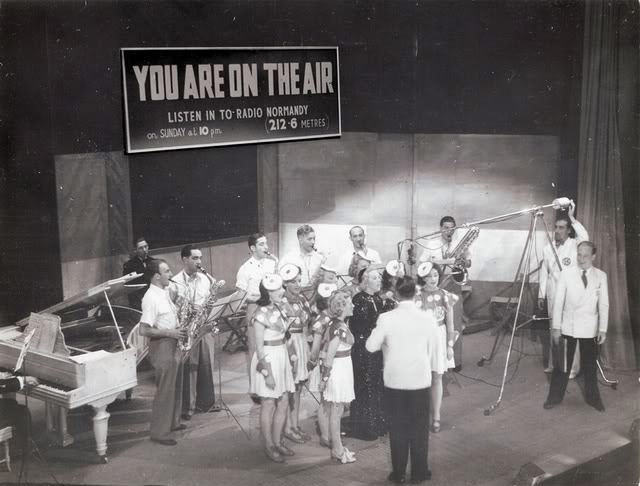 (still without authorisation) to 20 kW, the broadcasts already heard on the south coast of England reached London (200 km from Fécamp) in the middle of the day. At night, they reach the Midlands and the populated cities of Birmingham and Coventry in the north. On the French side, our parents and grandparents remember Tante Francine (Francine Lemaître), the first radio announcer, Uncle Roland (Roland Violette), accordionist Roger Queval and the whole Radio Normandie orchestra. On the British side, Roy Plomley, Ian (David) Newman, Bob Danvers Walker (Uncle Bob), David J. Davies, Howard V. Gee and E.J. Oestermann took turns at the microphone, with the assistance of a French technician. (still without authorisation) to 20 kW, the broadcasts already heard on the south coast of England reached London (200 km from Fécamp) in the middle of the day. At night, they reach the Midlands and the populated cities of Birmingham and Coventry in the north. On the French side, our parents and grandparents remember Tante Francine (Francine Lemaître), the first radio announcer, Uncle Roland (Roland Violette), accordionist Roger Queval and the whole Radio Normandie orchestra. On the British side, Roy Plomley, Ian (David) Newman, Bob Danvers Walker (Uncle Bob), David J. Davies, Howard V. Gee and E.J. Oestermann took turns at the microphone, with the assistance of a French technician.
NB: during the English broadcasts, the house rules stipulated the presence of a French member of staff alongside the English announcer. The reasons for this are unknown. Technical assistance or on-air control perhaps?
The station was expanding rapidly, but the power of the transmitter, with 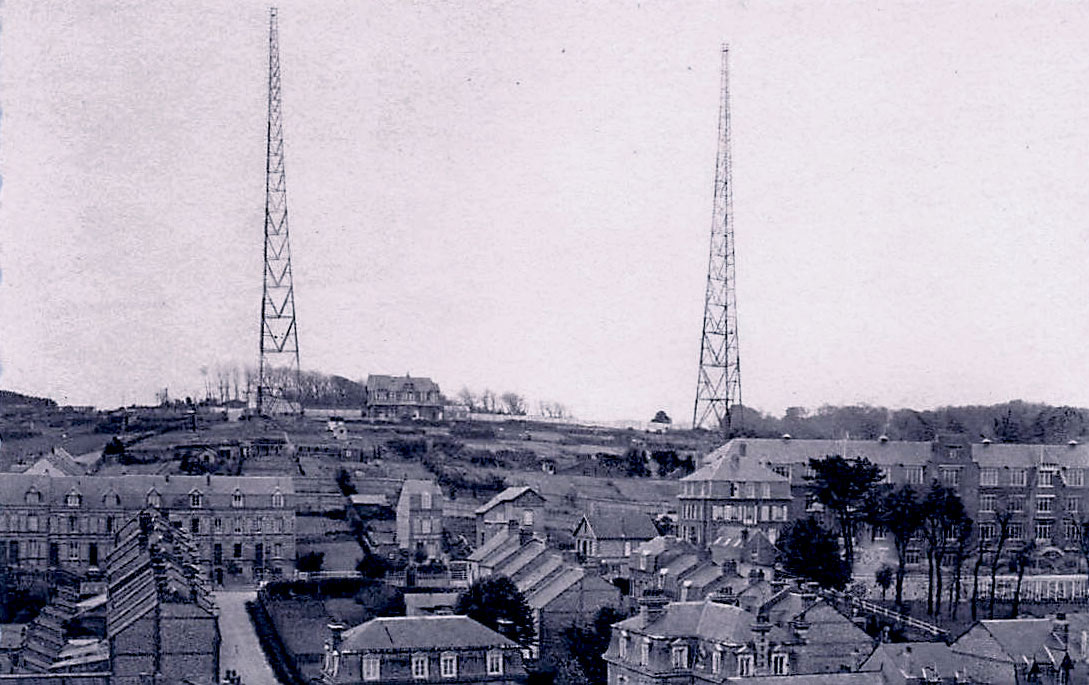 its antennae overhanging the town, overloaded the receivers (which were not very selective at the time) of the people of Fécamp, who were unhappy that they could not hear other distant stations without completely eliminating the sound of Radio Normandie, which was always present in the background. Plans were therefore made to move the transmitter. In 1938, the transmitting station was transferred to the heart of the Pays de Caux at Louvetot where, in the middle of a 3-hectare estate, a brand new transmitter was built at the foot of a revolutionary 154 m high 'Blaw-Knox' tower, which considerably increased the range of the broadcasts. A few kilometres below, on the banks of the Seine, new studios were built in a château, the future Town Hall of Caudebec-en-Caux. its antennae overhanging the town, overloaded the receivers (which were not very selective at the time) of the people of Fécamp, who were unhappy that they could not hear other distant stations without completely eliminating the sound of Radio Normandie, which was always present in the background. Plans were therefore made to move the transmitter. In 1938, the transmitting station was transferred to the heart of the Pays de Caux at Louvetot where, in the middle of a 3-hectare estate, a brand new transmitter was built at the foot of a revolutionary 154 m high 'Blaw-Knox' tower, which considerably increased the range of the broadcasts. A few kilometres below, on the banks of the Seine, new studios were built in a château, the future Town Hall of Caudebec-en-Caux.
A 6-kilometre coaxial cable laid through the Forêt de Maulévrier linked the studios to the transmitter. Thanks to the associated radio clubs, other studios (known as "auditoriums") were set up in Rouen, Le Havre, Le Tréport, Le Touquet and Paris (at the headquarters of the Paris-Soir newspaper to broadcast the news bulletin), all linked to Caudebec by PTT telephone lines: the technical quality of the sound at the time was pretty basic!
The French State, eager for control (its perpetual obsession), sought to appropriate the powerful Radio Normandie station at all costs. However, 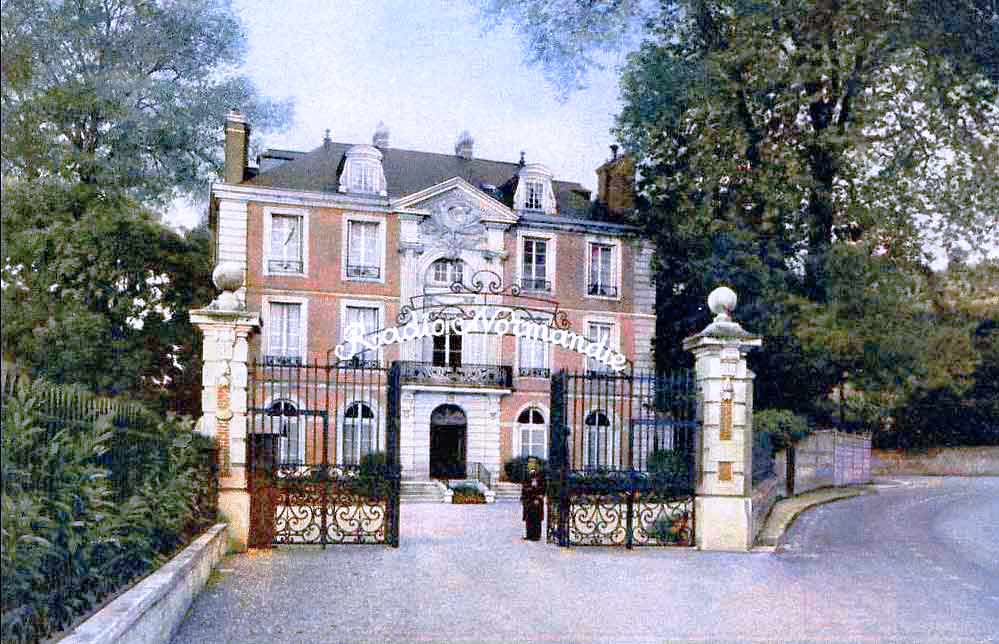 the station retained its autonomy. The first private radio station in the provinces, it provided a regular service until the outbreak of war (7.09.1939), when it was requisitioned by the State, which had achieved its aims. But the Nazies soon moved in and took over the station to relay Radio Paris's pro-German programme. The transmitter was bombed by Allied aircraft. What was left of the tower was blown down by the Wehrmacht as a final masterpiece during the debacle. The remaining French transmitters were sabotaged and destroyed by the retreating German army. the station retained its autonomy. The first private radio station in the provinces, it provided a regular service until the outbreak of war (7.09.1939), when it was requisitioned by the State, which had achieved its aims. But the Nazies soon moved in and took over the station to relay Radio Paris's pro-German programme. The transmitter was bombed by Allied aircraft. What was left of the tower was blown down by the Wehrmacht as a final masterpiece during the debacle. The remaining French transmitters were sabotaged and destroyed by the retreating German army.
At the Liberation, the French state immediately instituted the monopoly of the airwaves that had been so dear to its heart before the hostilities. Naturally, the licences granted to the former private radio stations were not renewed, as the State was convinced that "any activity intended to satisfy a need in the general interest must be carried out and controlled very closely by itself and its administration": the Public Service.
As a result, the RTF (Radiodiffusion et Télévision Française) was created in 1949. It obtained a monopoly on broadcasting.
After rebuilding a smaller transmitter tower (120 metres), the Louvetot transmitter had to relay national programmes (from Paris) on 214 m (1403 kHz): "Programme Parisien", "France Inter Variétés", then "France Culture". This state control over the installations definitively excludes any regional radio project, except for a few rare and brief dropouts during the 1960s which will have no follow-up, due to lack of audience or rather a lack of desire to continue the experiment. (...)
JC Dumenil |














